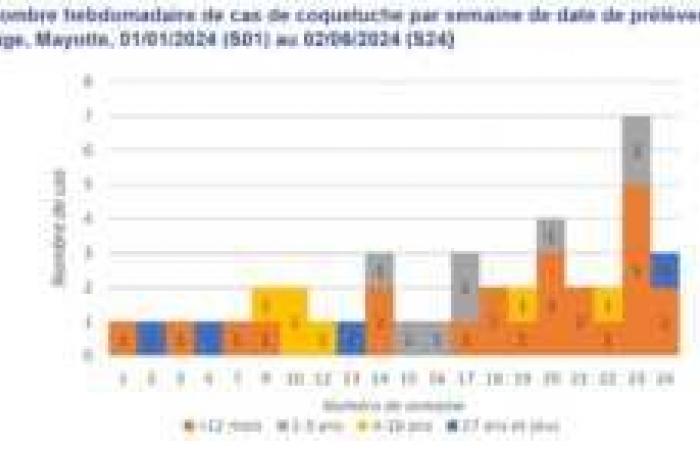In its regional epidemiological surveillance bulletin, Public Health France took stock of several diseases.
Whooping cough
Whooping cough is not a notifiable disease, however cases must be reported to the ARS when they are grouped (≥ 2 cases) or in the event of nosocomial infection. Surveillance in Mayotte is essentially based on laboratory data with the identification of the bacterium Bordetella pertussis.
Whooping cough results in Mayotte:
– 41 cases of whooping cough since the start of the year versus 16 in 2023 (+ 156%)
– Increase in whooping cough cases since H17-2024 (Figure 1)
– 56% of cases (n = 23) involved children under 1 year old
Typhoid fever
Typhoid fever is a notifiable disease.
In Mayotte, all cases of typhoid fever confirmed by blood culture and/or stool culture are reported to the Department of Safety and Health Emergencies (DéSUS) of the ARS Mayotte by the island’s laboratories (laboratory of the Mayotte Hospital Center ( CHM) and private laboratory). An investigation is carried out around each case by the ARS (DéSUS, environmental health service and field team) with Public Health France Mayotte (in the case of grouped cases). Information is collected using a specific questionnaire on clinical data and contamination risk factors. Samples and analyzes are also carried out when a water point is identified as a possible source of contamination.
In 2024, 28 cases of typhoid fever were reported to the ARS Department of Safety and Health Emergencies. The number of reported cases was highest in week 13 (5 cases). In W24, one case was reported after 4 weeks without any cases. These 28 cases of typhoid fever recorded in the first half of 2024 represent almost double the number of cases recorded throughout the year 2023 (15 cases).
It is the villages of M’tsapere and Hamouro (Bandrele) which report the most cases with 9 and 7 cases respectively.
Acute gastroenteritis
According to virological surveillance data, the positivity rate of pathogens responsible for GEA is increasing in H24/2024 (Figure 4). Concerning “Rectorate surveillance”, the activity rate has remained at a low level for 4 weeks (Figure 4). Regarding the sales data for anti-diarrheals and ORS, a decline has been observed since H21 (Figure 5).
Since week 19, a few cases of rotavirus have been recorded.
All epidemiological surveillance systems indicate that Mayotte is not in an epidemic context of AGE.
Dengue
In 2024, after 3 imported cases detected at the beginning of the year, a 1st indigenous case was detected in S13 (Petite Terre) where indigenous circulation gradually established itself. After a peak in S15 (9 cases), the number of cases decreased before experiencing a new peak in S20 (also 9 cases). After stabilizing in S22 and S23, the number of cases decreased again in S24 (2 cases).
Since the start of the year, 61 cases of dengue have been recorded, including 53 in Petite-Terre, which represents a rate of 87%. The median age of cases was 34 years (min: 6 years; max 74 years) and 56% of them were male.
Since the start of the year, 7 cases imported from Reunion Island, Mauritius and the Comoros have been identified. No serious cases have been reported and no deaths have been reported.
Measles
In 2023, 38 diseases will be notifiable (MDO). Among them, 36 are infectious diseases and 2 are non-infectious (mesothelioma and lead poisoning in minor children).
Measles is a highly contagious MDO with serious complications. It remains one of the major infectious scourges in the world. Thus, in France, an increase in cases has been observed in recent years during 2018 and 2019 and even if the measles virus circulated quietly in 2020-2021 throughout the territory, the emergence of epidemic outbreaks is still possible, especially in areas with poorer vaccination coverage.






